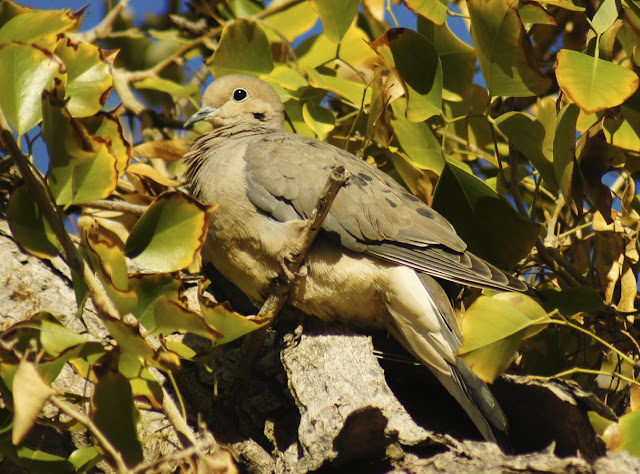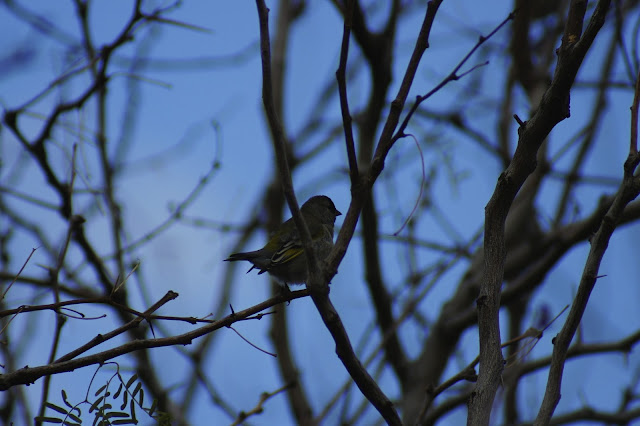I don't know what it is this winter, but the clouds seem determined to congregate only on the weekends. It was a fairly mild Saturday morning birding in Tempe, so today I decided to check out the Glendale Recharge ponds on the west side of town despite the weather. The Glendale ponds are operated by the SRP electric/water company and have varying water levels throughout the year. Their wider diameter and relative seclusion from the city noise makes them an ideal location for wintering waterfowl, including Goldeneye and Buffleheads, two ducks I've yet to see.
The recharge ponds are sandwiched in the no-man's land between the Glendale municipal airport and the new NFL stadium. There's a lot of big and important air traffic going in and out of Glendale, lots of messages to send...
Alas, this was the only Cardinal that I saw today.
When I arrived, I was a bit discouraged to see that the water levels were in fact very, very low. This meant I wouldn't be seeing many ducks, but it was also a boon in that I could now traverse much closer to where the birds were feeding out in the muck. With high water, you obviously have to keep to the banks, which reduces one to scope/binocular views only. Although it was very overcast, I probably would not have gotten good pictures with high water levels and good sunlight either, since everything would've been so far away. Given that the cloudy skies seemed to really encourage the birds, I was happy enough with the circumstances. But be forewarned, dear reader, this will be a very brown and muddy post.
There are about 6 ponds in total, and although they were all similarly drained, there was still an abundance of waders, peeps, and shorebirds out in the gunk.
The first bird of the day was a Greater Yellowlegs, and he was spending his Sunday savoring the last puddles of swamp. Although he was alone, there were maybe 16 Yellowlegs seen in total, and for the most part they were the largest waders around the ponds.
The Least Sandpipers were definitely the most numerous. I stopped counting after I passed 150; they were all over the place. I'm not sure if this little guy was looking for food or just admiring his reflection. It made me think though, how curious it must be to see one's reflection every time one goes to take a bite of food, to have to peck through one's own countenance for every tasty morsel.
At the opposite end of the size spectrum, there were probably a dozen Great Blue Herons perched on fences and in the trees around the complex. I didn't see a single one down in the ponds, probably because the lack of water meant there was a lack of fish.
With the water levels being so low and the ponds so wide, I decided to start cutting straight through instead of walking around the basins. The idea was both to save on time and to get some better looks at whatever was in the middle of the ponds, where the little bit of water still remained. This plan also had the advantage of keeping what little sunlight there was concentrated behind me, though it had the disadvantage of covering my shoes in smelly mud. It worked out pretty well, and I was able to add two more birds to my Life List that I would have likely otherwise missed.
That is not to say I came away with dynamite photos or anything. Believe it or not, there are 5 Horned Larks hanging out in there, and believe it or not they were quite beautiful. I had been expecting to see some Horned Larks this winter, but was not really expecting to find them in the middle of a drying lake bed, so even despite their skittishness it was a very pleasant surprise. It seems like a new bird sighting and good photos seldom go hand-in-hand anyway, so there were no hard feeling as the Larks kept their distance.

There were a lot of American Pipits running around the pond interiors as well, and they too were a new bird for me. Though they stayed in constant motion, they were more self-confident than the nearby Larks and Sandpipers. Pipits seem kind of unremarkable, like a cross between a Song Sparrow and a Yellow-Rumped Warbler instead of being a clear and unique species. Their tendency to flick and wag their tails, and their longer thumb/rear toe sets them apart.
Even though I wasn't anticipating any Pipits, they're pretty common in the right habitats, and they gave me frequent sightings throughout the morning. As with many of those little brown birds, there's still a lot to appreciate in their muted plumage.
While I was ambling around the northern-most ponds, a single Sandhill Crane flew overhead. At least, that's what I thought it was. The long legs hung out behind the lanky bird and it had a much stubbier beak than a Great Blue Heron. I couldn't make out any color on the bird though, and I still don't feel confident enough to write it down. As I set out in pursuit of the possible Crane, hoping it'd settle in the nearby farmland for some grazing (it didn't), I almost stepped on this Rock Wren.
He flew away and then stood very erect and very indignantly with his back towards me, letting me know that we were no longer friends.
At this point I had surveyed most of the ponds and the nearby farmland, which was inhabited entirely by Blackbirds and Mourning Doves. Perhaps the largest overall attraction of the day was the selection of Raptors that were hanging out on the outskirts of area. In addition to the basins, there's an adjoining (and unfortunately off-limits) flood/overflow-zone with a small stream and lots of higher trees and shrubs that were very popular with the bigger birds.

I followed this riparian area south while heading back to the car, and that last 30 minutes of birding yielded 6 Red-Tailed Hawks, 2 Cooper's Hawks, 1 Sharp-Shinned, 2 Osprey, and 1 Loggerhead Shrike.There were also abundances of Chipping Sparrows, Song Sparrows, Yellow-Rumped Warblers, Abert's Towhees, House Finches, and Gnatcatchers along the stream, and I could hear Kingfishers calling even though they stayed out of sight.

The last bird of the day was this smaller raptor (maybe 14 inches), who was perched on the telephone pole where I had parked. She took off right as I raised the camera and the resulting photo is just blurry and dark enough to end the day with a question mark. My original guess was a juvenile Sharp-Shinned Hawk, but I think it may actually be a Merlin.
The cloudy weather is supposed to hold through midday tomorrow--when I was planning on exploring the Gilbert Water Ranch for some rumored Lawrence's Goldfinches. Let's hope those clouds have a bust up and decide to part ways!






















































